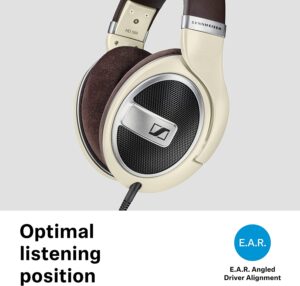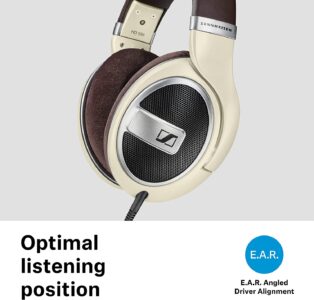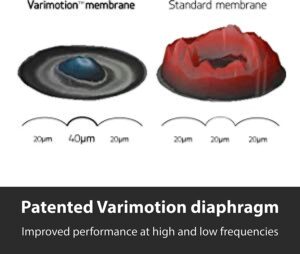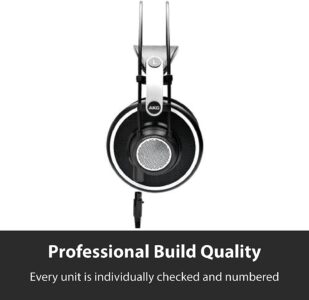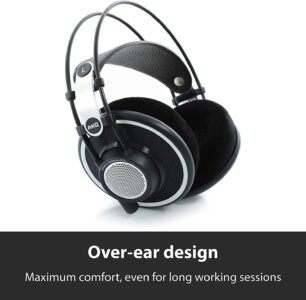Sound Quality: The Cornerstone of a Great Streaming Experience
Frequency Response
Sound quality is paramount for streaming. The frequency response of a headphone represents the range of audio frequencies it can reproduce. It is typically measured in Hertz (Hz) and is often represented as a range, such as 20Hz-20kHz, which is the standard range of human hearing.
Headphones with a wider frequency response can reproduce a broader range of audio frequencies, resulting in a more accurate and immersive listening experience. For instance, the AKG K702 boasts a wide frequency response of 10Hz-39.8kHz, which allows it to deliver excellent audio fidelity across various types of content.
Impedance
Impedance, measured in ohms (Ω), indicates the electrical resistance of the headphones. Lower impedance headphones (below 32Ω) are easier to drive and can be used with portable devices such as smartphones and laptops without requiring additional amplification. In contrast, higher impedance headphones (over 100Ω) typically require a dedicated headphone amplifier to reach their full potential.
For streaming, choosing headphones with an impedance that matches your audio source is crucial. The Audio-Technica ATH-M50x, with an impedance of 38Ω, is a popular choice for streamers due to its compatibility with a wide range of devices.
Soundstage and Imaging
Soundstage refers to the perceived spatial dimensions of the audio, while imaging describes the ability to pinpoint the position of individual sounds within the soundstage. Open-back headphones, like the Sennheiser HD 599, tend to have a larger soundstage and better imaging compared to closed-back models. This makes them ideal for streaming, as they provide a more immersive experience and make detecting subtle audio cues in games or movies easier.
Comfort: Ensuring Long Streaming Sessions Remain Enjoyable
Ear Cup Design and Padding
Comfort is crucial for streaming, as you may be wearing your headphones for extended periods. The design of the ear cups and the type of padding used can significantly impact comfort. Look for headphones with large, well-padded ear cups that can fully enclose your ears, such as the Beyerdynamic DT 770 PRO. This design helps to distribute pressure evenly and minimize fatigue during long sessions.
Memory foam padding is a premium option that conforms to the shape of your ears, offering excellent comfort and a secure fit. The Sony WH-1000XM5 features plush memory foam padding that ensures a comfortable fit even after hours of use.
Headband Design and Adjustability
A well-designed headband is essential for maintaining comfort and stability during long streaming sessions. Look for headphones with adjustable headbands that can accommodate various head sizes and shapes. Some models, like the AKG K702, feature self-adjusting headbands that automatically conform to your head for a custom fit.
Materials used in the headband also contribute to comfort. Padded headbands, such as the one found on the Audio-Technica ATH-M50x, reduce pressure on the top of your head and make it more comfortable to wear for extended periods.
Build Quality and Durability: Ensuring Longevity
Materials and Construction
The build quality of your headphones directly affects their durability and lifespan. High-quality materials, such as metal and high-grade plastic, are more likely to withstand daily wear and tear compared to cheaper alternatives. For instance, the Beyerdynamic DT 770 PRO utilizes a combination of robust materials, including metal and high-quality plastic, ensuring longevity and reliability.
In addition to the materials used, the overall construction of the headphones plays a significant role in durability. Look for headphones with reinforced joints and stress points, as these areas are more prone to damage over time. The Sony WH-1000XM5, for example, features a robust construction that can withstand the rigors of everyday use.
Replaceable Components
Headphones with replaceable components offer increased longevity, as you can easily swap out damaged or worn parts. Ear pads and cables are common replaceable components, but some models may also offer replaceable headbands or drivers. The AKG K702 has a detachable cable and replaceable ear pads, making it an excellent long-term investment for streamers.
Connectivity Options: Wired vs. Wireless
Wired Connectivity
Wired headphones, such as the Sennheiser HD 599, offer a reliable connection with minimal latency, making them ideal for streaming. They typically use a 3.5mm or 6.3mm audio connector, ensuring compatibility with a wide range of devices. Some models, like the Audio-Technica ATH-M50x, come with detachable cables that can be replaced if damaged or swapped out for different lengths and connector types.
When considering wired headphones, pay attention to the cable length and type. A longer cable allows for greater flexibility in your streaming setup, while a braided or reinforced cable can help prevent tangling and improve durability.
Wireless Connectivity
Wireless headphones, like the Sony WH-1000XM5, offer greater freedom of movement, eliminating the need for a cable connection. They typically use Bluetooth technology to connect to your devices and can also be used with Bluetooth transmitters for compatibility with non-Bluetooth sources.
While wireless headphones offer increased convenience, they may introduce latency, which can be problematic for streaming. However, some models feature low-latency codecs, such as aptX Low Latency, that can minimize this issue. Additionally, wireless headphones require periodic charging, which may interrupt your streaming sessions if not properly managed.
Noise Isolation and Leakage: Managing External Sound
Passive Noise Isolation
Passive noise isolation refers to the ability of the headphones to block out external sounds using their physical design and materials. Closed-back headphones, like the Beyerdynamic DT 770 PRO, provide better passive noise isolation than open-back models due to their sealed ear cups. This can be beneficial for streaming, as it allows you to focus on your content without being disturbed by environmental noise.
Sound Leakage
Sound leakage is the amount of audio that escapes the headphones and can be heard by those around you. Open-back headphones, such as the Sennheiser HD 599, tend to leak more sound than closed-back models. If you’re streaming in a shared space or want to avoid disturbing others, consider headphones with minimal sound leakage, like the Audio-Technica ATH-M50x.

Additional Features: Enhancing Your Streaming Experience
Active Noise Cancellation
Active noise cancellation (ANC) uses advanced technology to counteract external noise by generating an opposing sound wave, effectively canceling out unwanted sounds. While not essential for streaming, ANC can significantly enhance your listening experience in noisy environments. The Sony WH-1000XM5 features best-in-class ANC, allowing you to focus on your content even in the most challenging settings.
Foldable Design and Portability
A foldable design can make storing and transporting your headphones easier, which is particularly useful if you stream on the go or have limited space in your setup. The Audio-Technica ATH-M50x has a collapsible design that allows it to fold into a compact form, making it an excellent option for streamers who need a portable solution.
Customizable Sound Profiles
Some headphones offer customizable sound profiles, allowing you to fine-tune the audio to suit your preferences or the content you’re streaming. This can be particularly beneficial for streamers who switch between different types of content, such as music, movies, or games. The Sony WH-1000XM5, for example, features a companion app that enables you to create and save multiple sound profiles, ensuring an optimal listening experience regardless of the content.
Accessories and Included Extras
Many headphones come with additional accessories that can enhance your streaming experience. These may include carrying cases, additional ear pads, or different cable options. The AKG K702, for instance, comes with a premium carrying pouch and a detachable cable, providing added convenience and flexibility.
By considering these critical aspects when selecting the best headphones for streaming without a mic, you can find the perfect pair to suit your needs and elevate your streaming experience. Whether you prioritize sound quality, comfort, durability, or connectivity options, our top picks, including the Audio-Technica ATH-M50x, the Beyerdynamic DT 770 PRO, and the Sennheiser HD 599, offer exceptional performance and value.
Remember to weigh the pros and cons of each option, and don’t be afraid to invest in a quality pair of headphones that will enhance your streaming sessions for years to come. The best headphones for streaming without a mic can truly transform your content consumption, making every moment more immersive and enjoyable.
Balance Between Price and Performance
When choosing the best headphones for streaming without a mic, it’s essential to strike a balance between price and performance. While higher-priced headphones often offer better sound quality, build quality, and features, ensuring that you’re getting the best value for your money is crucial.
Consider your specific needs and budget when comparing different models. For instance, the Sennheiser HD 599 offers an excellent balance between sound quality and comfort at a more affordable price point compared to some high-end models. On the other hand, if you’re willing to invest in a premium option, the Sony WH-1000XM5 delivers top-notch active noise cancellation and customizable sound profiles, justifying its higher price.
Wired vs. Wireless for Streaming Purposes
As mentioned earlier, both wired and wireless headphones have their pros and cons when it comes to streaming. Wired headphones offer a more stable connection and minimal latency, making them popular for streamers. However, wireless headphones provide greater freedom of movement and eliminate the need for a cable connection, which can be advantageous in certain situations.
If you’re primarily streaming from a fixed location, such as a desktop computer or a gaming console, wired headphones like the Audio-Technica ATH-M50x or the Beyerdynamic DT 770 PRO may be more suitable. However, if you frequently stream on the go or prefer the convenience of wireless connectivity, the Sony WH-1000XM5 is an excellent option to consider.
Open-Back vs. Closed-Back for Immersive Streaming
The choice between open-back and closed-back headphones largely depends on your personal preferences and streaming environment. Open-back headphones, such as the AKG K702 and the Sennheiser HD 599, provide a more expansive soundstage and better imaging, which can enhance your immersion in games and movies. However, they typically offer less noise isolation and more sound leakage compared to closed-back models.
Closed-back headphones, like the Audio-Technica ATH-M50x and the Beyerdynamic DT 770 PRO, provide better noise isolation and reduce sound leakage, making them suitable for streaming in shared spaces or noisy environments. However, their soundstage may be more limited compared to open-back models.
Consider your specific streaming needs and the environment in which you’ll be using your headphones to determine your best option.
Compatibility with Streaming Devices
When selecting the best headphones for streaming without a mic, it’s essential to ensure that they’re compatible with the devices you’ll be using for streaming. Most wired headphones use a 3.5mm or 6.3mm audio connector, which is compatible with a wide range of devices, such as smartphones, laptops, gaming consoles, and audio interfaces. However, some wireless headphones may require a Bluetooth transmitter to connect to non-Bluetooth sources.
Before making a decision, verify that your chosen headphones are compatible with your streaming devices, and consider any additional equipment you may need, such as a headphone amplifier or a Bluetooth transmitter.











































